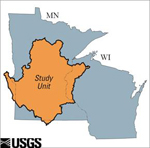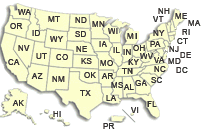
UMIS NAWQA
USGS IN YOUR STATE
USGS Water Science Centers are located in each state.

|
Ground Water Flow Path Study
The purpose of a flow path study is to investigate the fate of constituents in ground water from recharge areas (upland areas) to discharge areas (lowlands, wetlands, or streams). The flow path study for the UMIS NAWQA project is nested within the area encompassed by the Urban Land Use Study, on Shingle Creek, running along a transect from Brooklyn Park, Minnesota to Brooklyn Center, Minnesota (Figure 1). In late June of 1996, preliminary measurements of hydraulic head in the stream bed were conducted and pore-water samples were analyzed in the field to determine concentrations of nitrate and iron. Those preliminary measurements indicated that the stream loses and gains water from the surrounding sandy river-terrace aquifer, and that phreatic plants (specifically large willow trees) along the banks of the stream may have substantial effects of ground-water flow and chemistry in the vicinity of the stream.
Six multiport piezometers (each having four ports) were installed in May and June of 1997 to evaluate ground-water quality with depth in the surficial aquifer along the ground-water flowpath (Figure 2). The flowpath wells were sampled three times (July of 1997, October of 1997, and August of 1998). Water samples were analyzed to determine concentrations of major ions, nutrients, pesticides, volatile organic compounds, radon, tritium, and CFCs.
Goals for the planned flow-path study include the following:
- Investigation of ground-water ages in the surficial sand and gravel aquifer, focusing on denitrification.
- Investigation of ground-water ages in the surficial sand and gravel aquifer, using CFC age-dating.
- Investigation of the distribution of pesticides and volatile organic compounds in the surficial sand and gravel aquifer.
- Investigation of ground-water/surface-water interactions in the vicinity of Shingle Creek.
- Investigation of the effects of ground-water discharge to Shingle Creek on aquatic biota in the Creek.
- Investigation of the quality of ground-water discharging to the Mississippi River.
- Three-dimensional simulation of ground-water flow paths from the western boundary of the surficial sand and gravel aquifer to the discharge point along the Mississippi River.
- Development of a clearer understanding of ground-water flow dynamics and three-dimensional variations in ground-water quality in the Shingle Creek Basin.
|
Findings from this study are published in the following report:
Andrews, W.J., Stark, J.R., Fong, A.L., Fallon, J.D., 2005, Water-quality assessment of part of the Upper Mississippi River basin, Minnesota and Wisconsin - Ground-water quality along a flow system in the Twin Cities metropolitan area, Minnesota, 1997-98: U.S. Geological Survey Water-Resources Investigations Report 2005-5120, 44 p.
|
|

